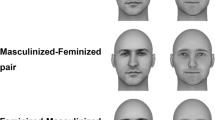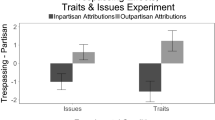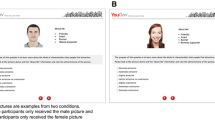Abstract
Recent national attention has focused on women's voting behavior because of this group's increasing power to determine outcomes of local, state, and national elections. Research has not established whether males and females use the same “decision rules” in evaluating political candidates. Because of the link between perceived physical attractiveness and many positive attributes, the present study examined sex differences in ratings of attractiveness and competence of 44 men and women in the U.S. House of Representatives. Results indicated that males and females use similar rules in evaluating male politicans' attractiveness. Women show a pro-female sentiment in evaluating female politicians' competence. Physical attractiveness was positively related to perceived competence for both male and female politicians. Contrary to previous research, women voters showed a marked pro-female sentiment, and men were neutral, evaluating male and female politicians similarly.
Similar content being viewed by others
References
Berscheid, E., & Walster, E. (1974). Physical attractiveness. In L. Berkowitz (Ed.), Advances in experimental social psychology (Vol. 7) New York: Academic Press.
Budge, H. S. (1981). Dimensions of physical attractiveness: How others see us (Doctoral Dissertation, University of Utah, 1981). Dissertations Abstracts International, 41, 4281-B.
Byrne, D. (1971). The attraction paradigm. New York: Academic Press.
Carlson, J. M., & Boring, M. K. (1981). Androgyny and politics. The effects of winning and losing on candidate image. International Political Science Review, 62, 481–491.
Dipboye, R. L., Arvey, R. D., & Terpstra, D. E. (1977). Sex and physical attractiveness of raters and applicants as determinants of resume evaluations. Journal of Applied Psychology, 62, 288–294.
Dipboye, R. L., Fromkin, H. L., & Wiback, K. (1975). Relative importance of applicant sex, attractiveness, and scholastic standing in evaluation of job applicant resumes. Journal of Applied Psychology, 60, 39–43.
Eagly, A. H., & Wood, W. (1982). Inferred sex differences in status as a determinant of gender stereotypes about social influence. Journal of Personality and Social Psychology, 43, 915–928.
Ehrenhalt, A., Amrine, R., & Duncan, (1987). Politics in America: The 100th Congress. Washington, DC: Congressional Quarterly.
Ezell, H. F., Odewahn, C. A., & Sherman, J. D. (1980). Perceived competence of women managers in public human service organizations: A comparative view. Journal of Management, 6, 135–144.
Feree, M. M. (1974). A woman for president? Changing responses: 1958–1972. Public Opinion Quarterly, 38, 390–399.
Hedlund, R. D., Freeman, P. K., Hamm, K. E., & Stein, R. M. (1979). The electability of women candidates: The effects of sex-role stereotypes. Journal of Politics, 41, 513–524.
Heilman, M. E. (1980). Sex discrimination. In B. B. Wolman & J. Money (Eds.), Handbook of human sexuality. Englewood Cliff, NJ: Prentice-Hall.
Heilman, M. E., & Saruwatari, L. R. (1979). When beauty is beastly; The effects of appearance and sex on evaluations of job applicants for managerial and nonmanagerial jobs. Organizational Behavior and Human Performance, 23, 360–372.
Heilman, M. E., & Stopeck, M. H. (1985). Being attractive, advantage or disadventage? Performance based evaluations and recommended personnel actions as a function of appearance, sex and job type. Organizational Behavior and Human Performance, 35, 202–215.
Helmreich, R. L., Spence, J. T., & Gibson, R. H. (1982). Sex-role attitudes: 1972–1980. Personality and Social Psychology Bulletin, 8, 656–663.
Hershey, M. R. (1980). Support for political women: The effects of race, sex, and sexual roles. In J. Pierce & J. Sullivan (Eds.), The electorate reconsidered. Beverly Hills, CA: Sage Publications.
Kirkpatrick, S. A., Lyons, W., & Fitzgerald, M. A. (1975). Candidates, parties and issues in the American electorate: Two decades of change. American Politics Quarterly, 3, 247–283.
Mahoney, E. R., & Finch, M. D. (1976). The dimensionality of body-cathexis. The Journal of Psychology, 92, 277–279.
Meisol, P. (1978). Women in politics—increasing in numbers, but not on the Hill. National Journal, 15, 1128–1131.
Olsen, N. J., & Williemsen, E. W. (1978). Studying sex prejudice in children. Journal of Genetic Psychology, 133, 203–216.
Rosen, B., & Jerdee, T. H. (1974a). Influence of sex-role stereotypes on personnel decision. Journal of Applied Psychology, 59, 9–14.
Rosen, B., & Jerdee, T. H. (1974b). Effects of applicant sex and difficulty of job on evaluation of candidates for managerial positions. Journal of Applied Psychology, 59, 511–512.
Rosen, B., & Jerdee, T. H. (1974c). Sex stereotyping in the executive suite. Harvard Business Review, 52, 45–58.
Rossi, A. S. (1983). Beyond the gender gap: Women's bid for political power. Social Science Quarterly, 64, 718–733.
Rovner, J. (1988, November 12). Characteristics of Congress. Congressional Quarterly Weekly Report, 46, 3293–3294.
Shaw, E. A. (1972). Differential impact of negative stereotyping in employee selection. Personal Psychology, 25, 333–338.
Sigelman, L., & Sigelman, C. (1982). Sexism, racism, and ageism in voting behavior. An experimental analysis. Social Psychology Quarterly, 45, 263–269.
Sigelman, C. K., Sigelman, L., Thomas, D. B., & Ribich, F. D. (1986). Gender, physical attractiveness, and electability: An experimental investigation of voter biases. Journal of Applied Psychology, 16, 229–248.
Simon, L. (1987). Who are the leaders? Journal of State Government, 60, 246–247.
Taylor, M. S., & Ilgen, D. R. (1981). Sex discrimination against women in initial placement decisions: A laboratory investigation. Academy of Management Journal, 24, 859–865.
Terborg, J. R., & Ilgen, D. R. (1975). A theoretical approach to sex discrimination in traditionally masculine occupations. Organizational Behavior and Human Performance, 13, 352–376.
U.S. Bureau of the Census, Department of Commerce. (1988). 1984 election characteristics of the voting-age population. Statistical Abstract of the United states. Washington, DC: U.S. Government Printing Office.
U.S. Equal Employment Opportunity Commission. (1972). Sixth annual report. Washington, DC: U.S. Government Printing Office.
Author information
Authors and Affiliations
Rights and permissions
About this article
Cite this article
Lewis, K.E., Bierly, M. Toward a profile of the female voter: Sex differences in perceived physical attractiveness and competence of political candidates. Sex Roles 22, 1–12 (1990). https://doi.org/10.1007/BF00288150
Issue Date:
DOI: https://doi.org/10.1007/BF00288150




